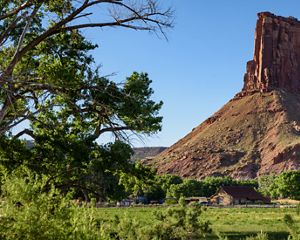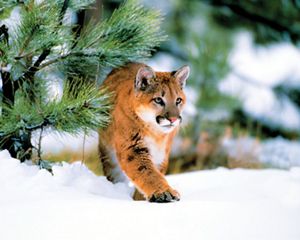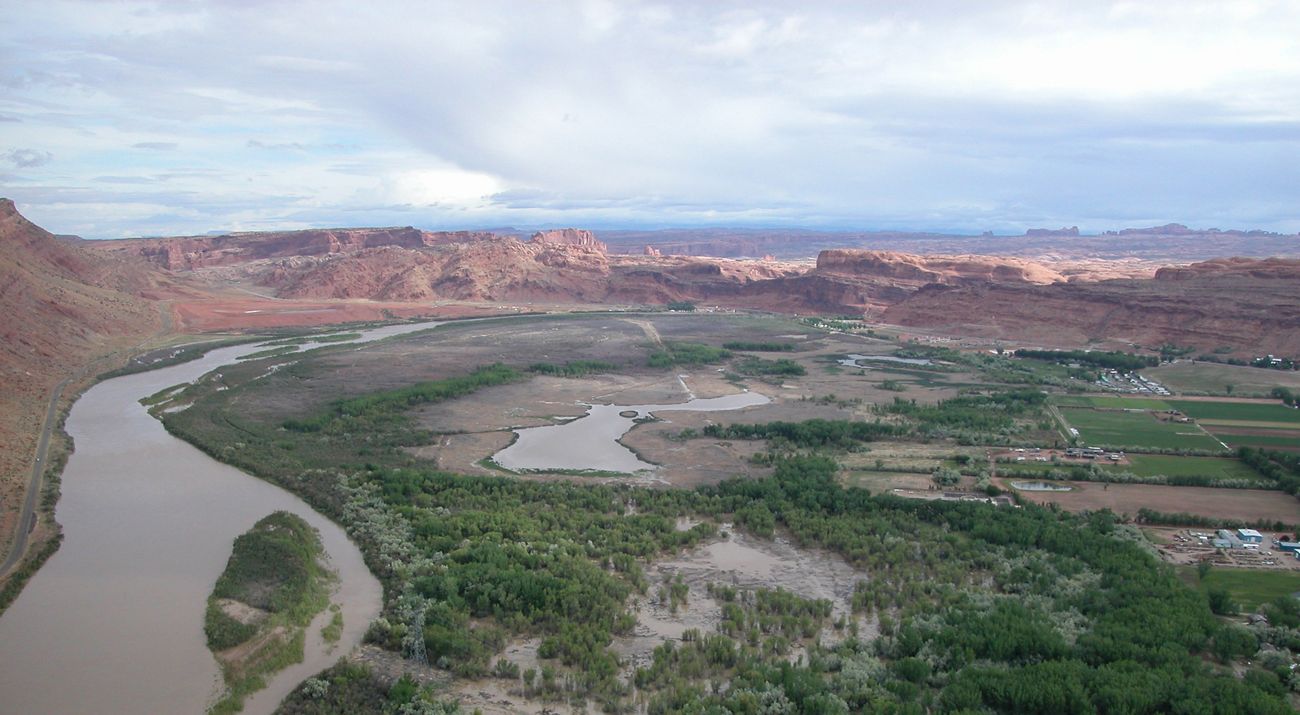
A Nursery for Endangered Fish—2024 Update
In the perfect spot on the Colorado River, we’re blending science and engineering to give razorback suckers a fighting chance.
By Larisa Bowen, Writer/Editor for The Nature Conservancy
2023 turned out to be a record year for the razorback sucker nursery at TNC’s Scott and Norma Matheson Wetlands Preserve. Ecstatic scientists counted a total of 51 juvenile razorback suckers in the fish nursery last fall.
The Colorado River’s high flows in 2023 benefitted the recruitment of these at-risk fish, and TNC’s nursery sheltered them at a crucial stage of development when they're at their most vulnerable. After maturing in the nursery wetlands during spring and summer, scientists carefully identified, tagged and released these young fish back into the river—giving them a new shot at life in the wild. The nursery class of 2023 experienced a significant increase in numbers compared to the previous two years and provides hope for the future for the endangered river fish.
Watch KSL-TV’s Visit to the Nursery
KSL-TV’s John Hollenhorst visited the preserve and learned more about the nursery.
Watch the ClipFor the Colorado River’s endangered razorback sucker, survival to adulthood is a struggle. The fish—which sports a tell-tale, sharp-edge hump behind its head—can live up to 40 years. Instead, today most don’t live past their first year.
At TNC’s Matheson Preserve near Moab, Utah, scientists and engineers are giving nature a boost. Taking advantage of the preserve’s location along the Colorado River, the team is bringing razorback sucker larvae into the preserve’s sheltered habitats in late spring, where they are protected during their most vulnerable stage of development.
Quote: Linda Whitham
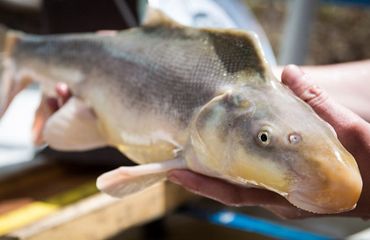
The widened channel is designed to bring more water into the preserve’s wetlands during key times of the year, mimicking the natural flows these fish need to develop.
Engineers have widened the river channel, allowing the water and larval razorback suckers to enter the preserve, floating through a control gate and into the central pond. After several months of safely growing in the preserve’s pond, the more mature fish are released back into the river’s mainstem in early fall.
The goal for this project? Restore what has been disrupted on the river through years of human impacts, and re-establish a wild, self-sustaining population of an endangered species.

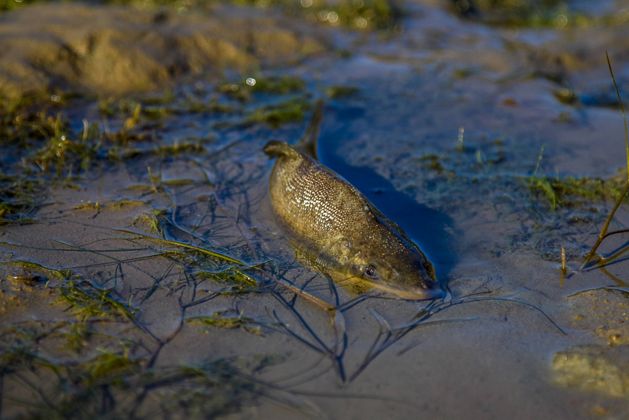
We Can’t Protect Utah Wildlife Without You
Sign up to receive monthly news and stories about our conservation work. Get a preview of Utah’s Nature News email.
A River Forever Changed
More than 100 years ago, razorback suckers thrived throughout the Colorado River Basin, at home in the swift waters of the free-flowing rivers in seven states and Mexico. They often migrated hundreds of miles in one year and grew up to 3 feet in length. But then the Colorado River entered a new era: one of dam building, increasing water withdrawals and sport fish stocking. Like other native fish, the razorback suckers began to die off, veering toward extinction as the Colorado River’s flows and habitats were altered.
Climate change—and its deepening impacts on the entire Colorado River Basin—hasn’t helped. Intensifying high temperatures and on-going low precipitation have caused river levels to drop steadily, with predictions even more dire for the future. “We used to say it’s a drought,” Taylor Hawes, TNC’s Colorado River Program Director, told the Durango Herald last summer. “After 19 years, we can say this is a pattern and trend that is punctuated by super dry years like 2002 and 2018.”
The sad reality is that for many native fish like the razorback sucker, the Colorado and its tributaries are drastically less livable.
It’s a Hard-Knock Youth
Since 1991, when the razorback sucker was placed on the Endangered Species list, conservation partners and state and federal agencies have been working throughout the Colorado River Basin to bolster populations. One key challenge is getting the fish in the wild to survive past their larval and juvenile phases. For reproduction and the first year of life, razorback suckers need slow-moving, back-eddy waters—a type of habitat that has been dramatically reduced along the Colorado as dams change flow dynamics and invasive plants crop up along river banks. To make matters worse, over the past 100 years, more than 70 non-native fish species have been introduced into the Colorado River Basin, many as sport fish. These invasive species wreak havoc on the river’s native ecosystem. Razorback sucker eggs and juveniles are easy prey for toothed non-native predators.
Quote: Linda Whitham

We need a way to help these fish survive the most vulnerable part of their life cycle.
Discovery at the Matheson Preserve
A few years ago, at TNC’s Matheson Preserve along the Colorado River near Moab, biologists made an exciting find while sampling for native fish. They uncovered a surprising number of wild-born razorback sucker larvae along the shoreline of the preserve. In fact, the scientists concluded the Matheson Preserve provides the only suitable nursery habitat for this species along 65 miles of the river. Encouraged by these findings, and the prospect that there could be a way to help these fish reach adulthood in the wild, TNC joined forces with the Utah Division of Wildlife Resources, Jones and DeMille Engineering, and PE Engineering to transform the preserve’s central pond into a protective nursery habitat for the fish.
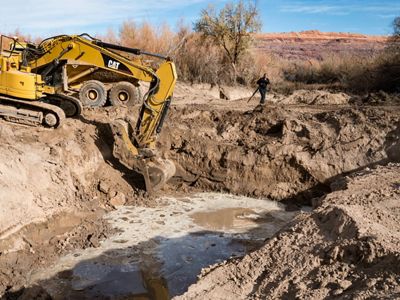
Creative Engineering
Inspired by a similar effort on the middle Green River near Jensen, Utah, the team of scientists and engineers modified a portion of the preserve’s wetlands by widening an existing channel from the Colorado River to the preserve’s central pond. This allows more water into the preserve during spring runoff—the time when the larvae need a safe place to grow.
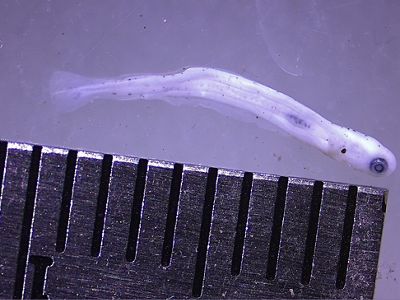
Engineers have also designed a control structure to channel both the water and the razorback larvae into the preserve. This unique structure is key for the nursery to succed. The concrete channel has a control gate and screen system that only allow larval fish to pass while keeping larger non-native predatory fish from entering. The structure also includes a fish capture area where the young fish can be measured and tagged before being released back to the Colorado River.
This fish nursery—the first on the Colorado River—could become a proven solution to help other threatened or endangered fish recover in western rivers.
Quote: Zach Ahrens
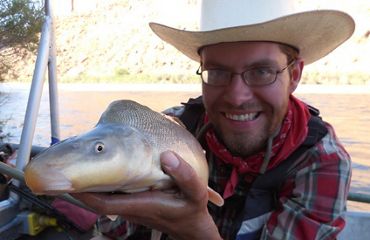
By flooding [the Matheson Preserve] more often and for longer periods, we expect to provide crucial habitat that these fish have lost.
TNC extends special thanks to the Department of Natural Resources Endangered Species Mitigation Fund Recovery Program, the Utah Watershed Restoration Initiative, the Utah Department of Transportation Mitigation Fund, and the Utah Division of Wildlife Habitat Council for their lead financial support on this project.
And stay tuned for updates as this endangered species rescue plan unfolds.
Quote: Linda Whitham
We hope to play an important role in re-establishing a wild, self-sustaining population of this endangered species.
Help us Protect Razorback Suckers
You can help us do important conservation work along the Colorado River and beyond.
Donate NowReport from the first release in 2021
In the fall of 2021, four olive-colored juvenile razorback suckers re-entered the Colorado River. These fish were the first to grow in the safety of the Matheson Preserve fish nursery.
“After a meager flood of the wetlands this spring, we feared no razorbacks had recruited,” said Zach Aherns, a fish biologist with Utah Division of Wildlife Resources, “but we were able to maintain sufficient water quantity and quality in the wetland through the long, hot summer.”
This “first class of fish graduates” was small, but scientists see their successful growth and re-introduction as an important indicator. If the nursery worked this well during a low water year, the project has the potential to make a much larger impact in species recovery in more favorable water years.
The U.S. Fish and Wildlife Service is now proposing to reclassify the status of the razorback sucker from endangered to threatened under the Endangered Species Act. This positive development is the result of hard work, partnership and creative thinking throughout the Colorado River Basin.
“Projects like our native fish nursery are really about stopping the loss of biodiversity—one species at a time,” said Linda Whitham, TNC’s Central Canyonlands regional manager. “It’s inspiring to have evidence that we can use science and engineering to restore nature.”
And it’s not just the fish who reap the benefits here. The nursery project has added over 50 acres of wetlands to the preserve, increased the quantity and quality of waterfowl and wildlife habitat and helped to reduce the risk of catastrophic wildfire.



